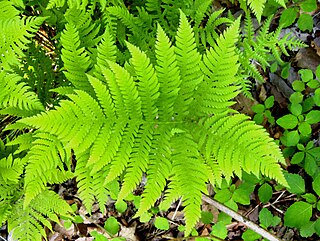
Phegopteris is a genus of ferns in the family Thelypteridaceae, subfamily Phegopteridoideae, in the Pteridophyte Phylogeny Group classification of 2016. They are known collectively as the beech ferns. Species are native to Asia, North America and Europe.

Blechnaceae is a family of ferns in the order Polypodiales, with a cosmopolitan distribution. Its status as a family and the number of genera included have both varied considerably. In the Pteridophyte Phylogeny Group classification of 2016, the family has 24 genera, and excludes genera placed in the separate family Onocleaceae. The family is divided into three subfamilies, including Blechnoideae s.s. Alternatively, the entire family may be treated as the subfamily Blechnoideae s.l. of a very broadly defined family Aspleniaceae, and include genera others place in Onocleaceae.

Hymenophyllum nephrophyllum, the kidney fern, is a filmy fern species native to New Zealand. It commonly grows on the forest floor of open native bush. Individual kidney-shaped fronds stand about 5–10 cm tall. In hot weather they shrivel up to conserve moisture, but open up again when the wet returns. This species has very thin fronds which are only four to six cells in thickness. In the Māori language they are also called raurenga.

Gleichenia microphylla is a small fern growing in Australia and New Zealand.

Hymenophyllum australe, commonly known as austral filmy fern, is a relatively large rupestral and epiphytic fern, indigenous to eastern Australia and New Zealand. It belongs to the unique Hymenophyllum genus, which are characterised by their thin membranous fronds that are seldom more than one cell thick, with the exception of regions over and around veins. Hymenophyllum australe is distinctive in that the fronds are typically thicker than other Hymenophyllum species, often being up to 2-3 cells thick.

Christella is a genus of around 70-80 species of ferns in the subfamily Thelypteridoideae of the family Thelypteridaceae in the Pteridophyte Phylogeny Group classification of 2016. Other sources sink Christella into a very broadly defined genus Thelypteris. The genus was named after Konrad H. Christ, a Swiss botanist. The distribution of these plants is mostly in the tropics and sub tropical areas. An Australian example is C. dentata.

Telmatoblechnum indicum or the swamp water fern is often seen growing on sandy soils in swampy areas. The specific epithet indicum is from Latin, revealing this plant was first collected in the East Indies (Java). Indigenous Australians used the starchy rhizome as food.

Lygodium japonicum is a species of fern that is known by the common names vine-like fern and Japanese climbing fern. It is native to eastern Asia, including Taiwan, Japan, Korea, southeastern Asia, and India, and eastern Australia. The fern is present in the southeastern United States and Puerto Rico as an introduced species.

Parapolystichum microsorum, synonym Lastreopsis microsora, known as the creeping shield fern is a common small plant found in eastern Australia and New Zealand. The habitat is rainforest or moist sheltered eucalyptus forests. It may form large colonies. The specific epithet microsora translates to "small sori".
Hymenasplenium is one of three genera of ferns in the Aspleniaceae, in the eupolypods II clade of the order Polypodiales. The others are Hemidictyum and Asplenium. Hymenasplenium was segregated because it is a natural grouping with differing rhizome morphology – dorsiventral v. radial for the rest of Asplenium, differing chromosome count – x=39 v. x=36 for the rest of Asplenium, and a clear monophyletic grouping based on genetic analysis. It was confirmed as a sister group to Asplenium in a 2015 molecular study of the genera.

Phlegmariurus varius, is a fir moss or club moss in the family Lycopodiaceae found in areas of Australia, New Zealand and associated islands. It has a number of synonyms including Huperzia varia.

Dicksonia lanata is a fern endemic to New Zealand. Colloquial names include stumpy tree fern, tūākura and tūōkura.
Tmesipteris horomaka, commonly known as the Banks Peninsula fork fern, is a fern ally endemic to New Zealand.

Hemionitis is a genus of ferns in the subfamily Cheilanthoideae of the family Pteridaceae. Its circumscription varies greatly in different systems of fern classification. In the Pteridophyte Phylogeny Group classification of 2016, it was one of more than 20 genera in the subfamily Cheilanthoideae, and was said to have five species. Other sources treat it as the only genus in the subfamily, and so accept about 450 species. With the restricted circumscription, species are native to tropical America.
Arthrobotrya is a genus of ferns in the family Dryopteridaceae, subfamily Elaphoglossoideae, in the Pteridophyte Phylogeny Group classification of 2016. The genus is native to Australia and New Zealand.
Teratophyllum is a genus of ferns in the family Dryopteridaceae, subfamily Elaphoglossoideae, in the Pteridophyte Phylogeny Group classification of 2016. The genus is native to Malesia.

Parapolystichum is a genus of ferns in the family Dryopteridaceae, subfamily Elaphoglossoideae, in the Pteridophyte Phylogeny Group classification of 2016. The genus is mainly native to the tropics, although its range extends to southeastern Australia.
Hiya is a genus of ferns belonging to the family Dennstaedtiaceae. Described in 2018, it resembles ferns of the genus Hypolepis but differs from it by multiple characteristics: scrambling, indeterminate and intermittent growth of fronds; stipule-like pinnules at the base of pinnae, and a rachis-costa architecture where the adaxial sulcus of the rachis is continuous with that of the costae and costules.

Telmatoblechnum serrulatum, the toothed midsorus fern, is a species of fern in the family Blechnaceae, native to Florida, southeastern Mexico, Central America, the Caribbean, northern and western South America, Brazil, Paraguay, and northeastern Argentina.

Patrick John Brownsey was a British-born botanist specialising in the systematics of New Zealand ferns, and was for 44 years curator of botany at the National Museum of New Zealand and Te Papa.














